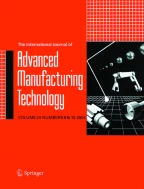Abstract
When drilling holes, burrs are created in particular on the exit surface. Existing deburring tools and methods enable the deburring of plane exit surfaces or slightly curved cross-drilled holes. However, these tools do not meet practical requirements for deburring in the machining industry where component geometries are often complex. This paper presents a numerical method, which enables deburring of complex-shaped drilling intersections with ball-end cutters. First, the particular intersection is analysed as it defines the maximum tool diameter of the ball-end cutter. Subsequently, a three-axis tool path for ball-end cutters is generated to correlate with the intersection geometry thus enabling constant chamfering and avoiding tool collisions. The model is verified by an experiment using the material AlSi7Mg and measuring secondary burr heights and chamfer widths. Subsequently, the functionality of the model for further geometry variants is investigated.
Similar content being viewed by others
References
Gillespie LK, Blotter PT (1976) The formation and properties of machining burrs, J Eng Ind Trans ASME Feb:66–74
Gillespie LK, Albright RK, Neal BJ (1976) Burrs produced by end milling, Bendix, Kansas City Division, BDX6131503
Dornfeld DA, Kim JS, Dechow H, Hewson J, Chen LJ (1999) Drilling burr formation in titanium alloy, Ti-6Al-4V. Ann CIRP 48(1):73–76
Dornfeld DA (2004) Strategies for preventing and minimizing burr formation, CIRP HPC Conference, Aachen
Min S, Kim J, Dornfeld DA (2001) Development of a drilling burr control chart for low alloy steel, AISI4118. J Mater Process Technol 113:4–9
Aurich JC, Dornfeld DA, Arrazola PJ, Franke V, Leitz L, Min S (2009) Burrs–analysis, control and removal. CIRP Ann Manuf Technol 58(2):519–542
Beier H-M, Nothnagel R (2015) Praxisbuch Entgrattechnik – Wegweiser zur Gratminimierung und Gratbeseitugung für Konstruktion und Fertigung, 2nd edn. Hanser, München
Aurich JC (2006) SpanSauber – Ergebnisbericht der Untersuchung zur Beherrschung der Sauberkeit von zerspanend hergestellten Bauteilen, Lehrstuhl für Fertigungstechnik und Betriebsorganisation. Technische Universität Kaiserslautern, Kaiserslautern
Gillespie LK (1979) Deburring precision miniature parts. Precis Eng 1(4):189–198
Lee UL, Ko SL (2008) Development of deburring tool for burrs at intersecting holes. J Mater Process Technol 201:454–459
Beier H-M, Nothnagel R (2005) Hochgeschwindigkeitsentgraten, wt Werkstattstechnik online 95:821–827
Kim KH, Park NJ (2005) A new deburring tool for intersecting holes. Proc Inst Mech Eng B J Eng Manuf 219:865–870
Cho C-H, Kim K-H (2010) Product development with TRIZ: design evolution of deburring tools for intersecting holes. J Mech Sci Technol 24:169–173
Cho C-H, Chae S-W, Kim K-H (2014) Search for a new design of deburring tools for intersecting holes with TRIZ. Int J Manuf Technol 70:2221–2231
Ton TP, Park HY, Ko SL (2011) Experimental analysis of deburring process on inclined exit surface by new deburring tool. CIRP Ann Manuf Technol 60:129–132
Avila MC (2004) Deburring of cross-drilled hole intersections by mechanized cutting, LMA. Annual Reports, pp 10–20
Güth S, Abele E (2013) Automatisiertes Entgraten von Kreuzbohrungen–Werkzeugbenchmark, Werkstatt – Betrieb, WB10:74–78
Pischan M (2013) Deburring of cross holes in titanium using industrial robots, WGP congress. Adv Mater Res 769:147–154
Schützer K, Abele E, Güth S (2015) Simulation-based deburring tool and process development. CIRP Ann Manuf Technol 64:357–360
Sato T, Sato Y, Maekawa T (2016) Tool path generation for chamfering drill holes of a pipe with constant width. Comput Aided Des 78:26–35
Abele E, Schützer K, Güth S, Meinhard A (2018) Deburring of cross-drilled holes with ball-end cutters – modeling the tool path. Prod Eng 12:25–33
Yong T, Narayanaswami R (2003) A parametric interpolator with confined chord error, acceleration and deceleration for NC machining. Comput Aided Des 35:1249–1259
Helleno AL, Schützer K (2006) Investigation of tool path interpolation on the manufacturing of die and molds with HSC technology. J Mater Process Technol 179:178–184
Schützer K, Stroh C, Schulz H (2010) C-space based approach for the calculation of toolpaths for freeform surfaces in B-spline description. CIRP Ann Manuf Technol 59:421–424
Acknowledgements
The authors are responsible for the content of this publication. The authors are also grateful to the anonymous reviewers for their constructive criticism which served to improve this paper.
Funding
This research and development project is funded by the German Research Foundation (DFG AB 133/94-1).
Author information
Authors and Affiliations
Corresponding author
Rights and permissions
About this article
Cite this article
Schützer, K., Abele, E., Meinhard, A. et al. Deburring of complex-shaped drilling intersections: a numerical method for modelling the tool path. Int J Adv Manuf Technol 102, 67–79 (2019). https://doi.org/10.1007/s00170-018-3205-1
Received:
Accepted:
Published:
Issue Date:
DOI: https://doi.org/10.1007/s00170-018-3205-1



